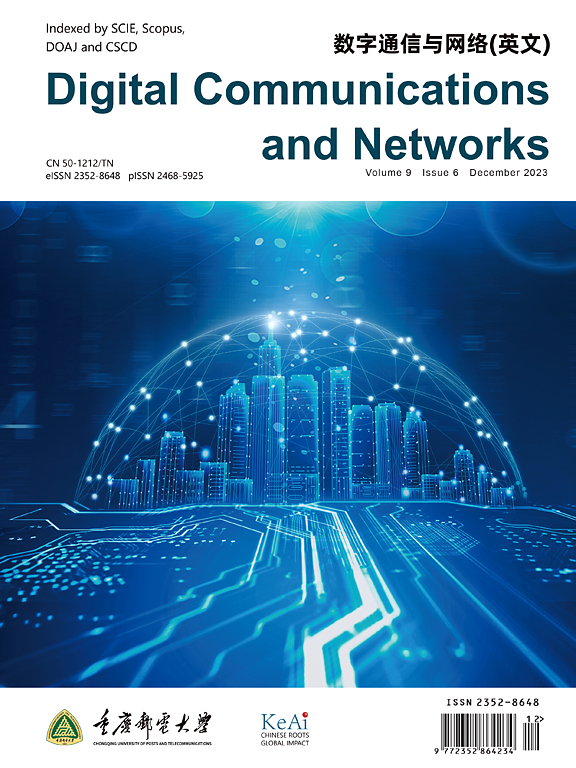可调随机线性网络编码(ARLNC):动态物联网计算环境中的数据传输解决方案
IF 7.5
2区 计算机科学
Q1 TELECOMMUNICATIONS
引用次数: 0
摘要
在移动计算环境中,大多数连接到网络的物联网设备都有不同的错误率,并且带宽有限。数据传输协议中常用的对传输过程中丢失的信息进行重传的传统方法增加了传输延迟,并且占用了过多的带宽。为了克服这个问题,可以在数据传输中使用前向纠错技术,例如随机线性网络编码(RLNC)。基于rnc的方法面临的主要挑战是在数据传输过程中保持一致的编码比,这会导致动态网络条件下显著的带宽使用和传输延迟。因此,本研究提出了一种新的基于块的RLNC策略,即可调RLNC(可调RLNC, ARLNC),该策略根据接收机反馈计算出的估计网络错误率,在运行时动态调整编码比和传输窗口。这种方法的计算是使用256阶的伽罗瓦域来执行的。此外,我们通过将ARLNC应用于各种误差模型(如Gilbert Elliott、指数和常数率)来评估其性能,并将其与标准RLNC进行比较。结果表明,在大多数情况下,根据网络情况动态调整编码比和传输窗口大小可以显著提高网络吞吐量,降低总传输延迟。与采用固定编码比的传统RLNC方法相比,该方法具有显著的增强,传输延迟降低73%,吞吐量提高4倍。然而,在动态计算环境中,ARLNC通常比标准RLNC产生更高的计算成本,但在高性能网络中表现优异。本文章由计算机程序翻译,如有差异,请以英文原文为准。
Adjustable random linear network coding (ARLNC): A solution for data transmission in dynamic IoT computational environments
In mobile computing environments, most IoT devices connected to networks experience variable error rates and possess limited bandwidth. The conventional method of retransmitting lost information during transmission, commonly used in data transmission protocols, increases transmission delay and consumes excessive bandwidth. To overcome this issue, forward error correction techniques, e.g., Random Linear Network Coding (RLNC) can be used in data transmission. The primary challenge in RLNC-based methodologies is sustaining a consistent coding ratio during data transmission, leading to notable bandwidth usage and transmission delay in dynamic network conditions. Therefore, this study proposes a new block-based RLNC strategy known as Adjustable RLNC (ARLNC), which dynamically adjusts the coding ratio and transmission window during runtime based on the estimated network error rate calculated via receiver feedback. The calculations in this approach are performed using a Galois field with the order of 256. Furthermore, we assessed ARLNC's performance by subjecting it to various error models such as Gilbert Elliott, exponential, and constant rates and compared it with the standard RLNC. The results show that dynamically adjusting the coding ratio and transmission window size based on network conditions significantly enhances network throughput and reduces total transmission delay in most scenarios. In contrast to the conventional RLNC method employing a fixed coding ratio, the presented approach has demonstrated significant enhancements, resulting in a 73% decrease in transmission delay and a 4 times augmentation in throughput. However, in dynamic computational environments, ARLNC generally incurs higher computational costs than the standard RLNC but excels in high-performance networks.
求助全文
通过发布文献求助,成功后即可免费获取论文全文。
去求助
来源期刊

Digital Communications and Networks
Computer Science-Hardware and Architecture
CiteScore
12.80
自引率
5.10%
发文量
915
审稿时长
30 weeks
期刊介绍:
Digital Communications and Networks is a prestigious journal that emphasizes on communication systems and networks. We publish only top-notch original articles and authoritative reviews, which undergo rigorous peer-review. We are proud to announce that all our articles are fully Open Access and can be accessed on ScienceDirect. Our journal is recognized and indexed by eminent databases such as the Science Citation Index Expanded (SCIE) and Scopus.
In addition to regular articles, we may also consider exceptional conference papers that have been significantly expanded. Furthermore, we periodically release special issues that focus on specific aspects of the field.
In conclusion, Digital Communications and Networks is a leading journal that guarantees exceptional quality and accessibility for researchers and scholars in the field of communication systems and networks.
 求助内容:
求助内容: 应助结果提醒方式:
应助结果提醒方式:


